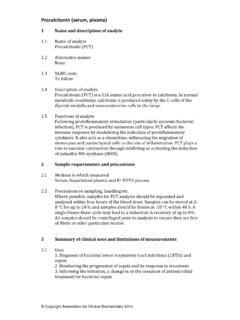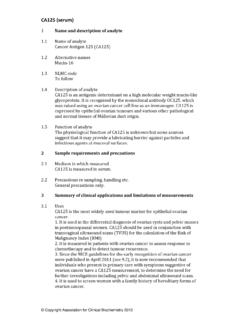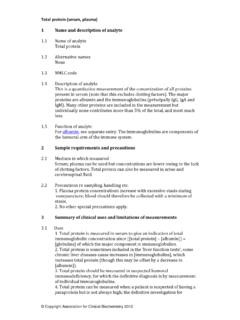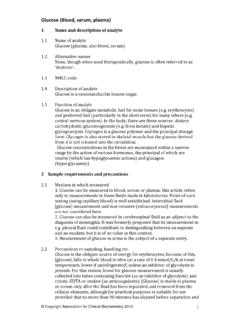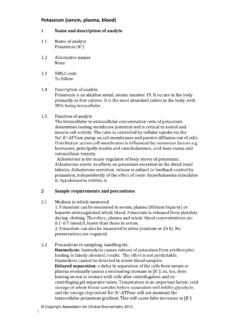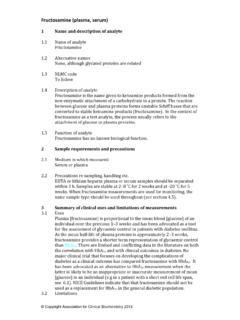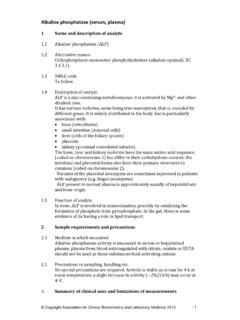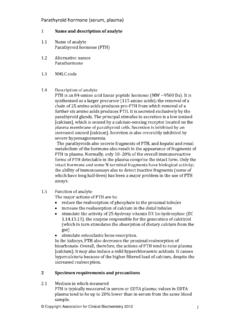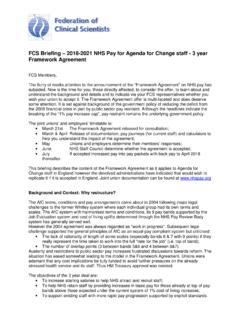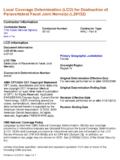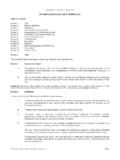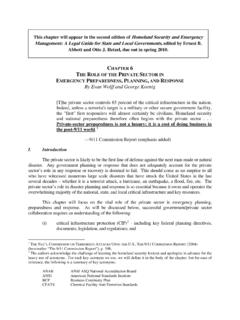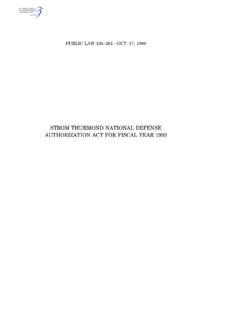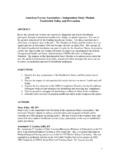Transcription of Alanine aminotransferase (serum, plasma)
1 Alanine aminotransferase (serum, plasma) 1 Name and description of analyte Name of analyte Alanine aminotransferase (ALT) Alternative names Systematic name L Alanine :2 oxoglutarate aminotransferase (EC ); also pyruvate aminotransferase , glutamate pyruvate aminotransferase ; formerly known as Alanine transaminase. NLMC code Description of analyte ALT is an intracellular cytoplasmic enzyme. It is widely distributed throughout the body's tissues, with the greatest amounts in liver and the kidneys. Function of analyte ALT catalyses the transfer of amino groups from Alanine (forming pyruvate) to 2 oxoglutarate (forming glutamate).
2 It is a key enzyme in gluconeogenesis. ALT present in the plasma is presumed to be derived from the normal turnover of tissue cells; increased quantities (the enzyme is usually assayed by measuring its activity, see ) are found in tissue damage (particularly hepatic damage). It is not known to have any function in plasma. 2 Sample requirements and precautions ALT is measured in plasma or serum. General precautions only. 3 Summary of clinical uses and limitations of measurements Uses ALT is used to identify liver damage arising from liver cell inflammation or necrosis. Its classification as a liver function test (LFT) is erroneous but has become accepted usage and seems likely to prevail.
3 Although ALT is widely distributed, significant increases in its plasma activity are rarely seen other than in liver disease. It may be measured both in patients with clinical features suggestive of liver disease and in patients at risk of developing liver disease. This latter category includes individuals with: a high alcohol intake a history or known or possible exposure to hepatitis viruses obesity or diabetes a history of consumption of potentially hepatotoxic drugs a family history of liver disease. Copyright association for Clinical Biochemistry 2012. Limitations An increase in ALT is an indicator of (hepatic) tissue damage; the highest values are seen in toxic damage induced by acetaminophen (paracetamol) poisoning, but an increase does not on its own provide any information about the cause of that damage (though see ).
4 4 Analytical considerations Analytical methods In common with the methods used for measuring most enzymes for clinical purposes, ALT is assayed by measuring its catalytic activity, not its mass. The ALT reaction involves an amino acid and an oxo acid both as substrates and products. Quantitation makes use of the formation of the oxo acid (pyruvate), using lactate dehydrogenase (lactate:NAD+ oxidoreductase, EC ) to reduce it with NADH to form lactate. The reaction is followed by measuring the decrease in absorbance at 340 nm. Alanine + 2 oxoglutarate (ALT) pyruvate + glutamate Pyruvate + NADH + H+ (LD) lactate + NAD+ Pyridoxine 5' phosphate is a coenzyme for the ALT reaction; its addition to the reaction mixture ensures that all the apoenzyme is catalytically active and measured.
5 Preincubation is required to remove any endogenous oxo acids from the reaction mixture, the reaction then being started by the addition of 2 oxoglutarate. Reference method This is based on the method described in Reference materials IRMM (Institute for Reference Methods and Materials)/IFCC (International Federation of Clinical Chemistry 454. Interfering substances Interference by endogenous oxo acids is eliminated as described in ( ). Sources of error As with all assays involving measurement of enzyme activity, strict control of reaction conditions, especially temperature, is essential.)
6 5 Reference intervals and variance Reference interval: (adults and children) 34 U/L (female), 45 U/L (ale) Reference intervals (others): values above applicable to all ages Extent of variation Interindividual CV: 24% Intraindividual CV: 16% Index of individuality: CV of method: Critical difference: 65% Copyright association for Clinical Biochemistry 2012. Sources of variation: the high levels of intra and interindividual variation reflect the fact that normal plasma levels are determined by cell turnover and not subject to any form of feedback control. 6 Clinical uses of measurement and interpretation of results Uses and interpretation 1.
7 See ALT is measured as an index of liver damage for which it is more specific than aspartate aminotransferase (AST). Values >20x the upper limit of normal may occur with severe liver damage. Smaller increments (usually <5xULN) may occur in cholestasis, due to secondary damage to hepatocytes. 2. In established liver disease, a falling ALT value usually reflects decreasing cell damage, but may occasionally be a consequence of such massive destruction that, with clearance of the enzyme, even continuing damage does not maintain high levels. 3. In the context of liver disease, measuring both ALT and AST provides little additional information over that provided by measuring either one.
8 There are two exceptions: in fatty liver disease, an activity ratio AST/ALT of >2 suggests alcohol as a cause; a ratio of 1 is suggestive of a non . alcoholic cause. Confounding factors None 7 Causes and investigation of abnormal results High values Causes 1. Hepatobiliary disease Liver cell necrosis ( in viral hepatitis, toxic liver damage); values may be >20x upper limit of normal (ULN). Cholestatic and other forms of hepatiobiliary disease; values rarely exceed 5x ULN unless there is accompanying liver cell necrosis. 2. Extrahepatic disease Relative to plasma, the activity of ALT in various tissues is: liver, 2850x, kidneys,1200x, heart 450x, skeletal muscle 300x.
9 Small increases in plasma ALT activity may therefore occur in acute kidney injury, myocardial infarction or skeletal muscle damage, but the increase in aspartate aminotransferase (AST) activity in these conditions is usually higher. Investigation Although ALT should only be measured when hepatobiliary disease is suspected on clinical grounds, in practice it is frequently measured as part of a panel of tests liver function tests' (but see ). However, chronic liver disease can present non specifically so that ALT measurement is frequently requested in the absence of classic features of liver disease ( jaundice).
10 The important practical question may then arise as to the action to be taken if an unexpectedly high ALT value is found. For any value, a high alcohol intake, diabetes or hypertriglyceridaemia (all of which can cause fatty liver) should be excluded; if present, these should be managed appropriately before repeating the test. Copyright association for Clinical Biochemistry 2012. For increases 2x ULN, and other LFTs normal, repeat in 1 2 months. If repeat value 3x ULN, further investigation is required. Values >3x ULN further investigation is required without repeat testing irrespective of results of other LFTs.
